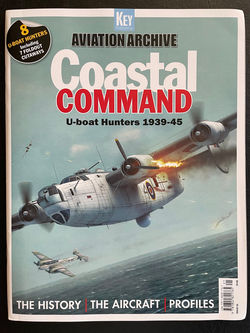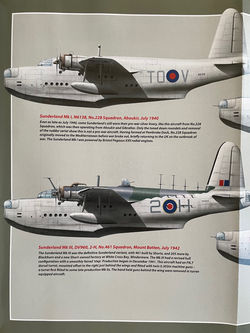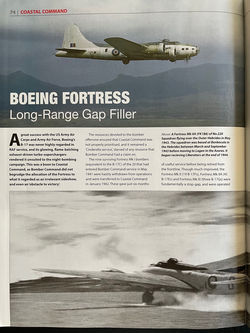WW2 RAF
COASTAL COMMAND AIRCRAFT U-BOAT SUBMARINE HUNTERS 1939-45 NORTH ATLANTIC
INCLUDES FOLD-OUTS, CUTAWAY
DRAWINGS AND COLOR PROFILES
SOFTBOUND BOOK in ENGLISH
SHORT SUNDERLAND
LOCKHEED HUDSON
CONSOLIDATED CATALINA
VICKERS WELLINGTON
CONSOLIDATED LIBERATOR
BOEING FORTRESS
AVRO ANSON
ARMSTRONG WHITWORTH WHITLEY
----------------------------------------------------------------------------------------------
Additional Information from
Internet Encyclopedia
RAF Coastal Command was a
formation within the Royal Air Force (RAF). Founded in 1936, it became the
RAF's only maritime arm when the Fleet Air Arm was transferred to the Royal
Navy in 1937. Naval aviation had been neglected in the inter-war period, due to
the RAF having control of the aircraft flying from Royal Navy carriers. As a
consequence Coastal Command did not receive the resources it needed to develop
properly or efficiently. This continued until the outbreak of the Second World
War, during which it came to prominence. But owing to the Air Ministry's
concentration on RAF Fighter Command and RAF Bomber Command, Coastal Command
was often referred to as the "Cinderella Service", a phrase first
used by the First Lord of the Admiralty at the time A V Alexander.
Coastal Commands's primary task
became the protection of Allied convoys from attacks by the German
Kriegsmarine's U-boats, groups of which were known as "wolfpacks". It
also protected Allied shipping from aerial attacks by the Luftwaffe. The main
operations of Coastal Command were defensive, defending supply lines in the
various theatres of war, most notably the Mediterranean, Middle East and
African, and the battle of the Atlantic. It also had an offensive capacity. In
the Mediterranean theatre and the Baltic sea it attacked German shipping
carrying war materials from Italy to North Africa and from Scandinavia to
Germany. By 1943 Coastal Command finally received sufficient Very Long Range
[VLR] aircraft it needed and its operations proved decisive in the victory over
the U-boats. These aircraft were Consolidated B-24 Liberators and, from early
1943, these, and other Coastal Command aircraft, were fitted with Mark III ASV
[air-to-surface vessel] centimetric radar, the latest depth charges, including
homing torpedoes, officially classed as Mark 24 mines [nicknamed 'Wandering
Annie' or 'Wandering Willie'] and even rockets.
The Command saw action from the
first day of hostilities until the last day of the Second World War. It
completed one million flying hours, 240,000 operations and destroyed 212
U-boats. Coastal Command's casualties amounted to 2,060 aircraft to all causes.
From 1940 to 1945 Coastal Command sank 366 German transport vessels and damaged
134. The total tonnage sunk was 512,330 tons and another 513,454 tons damaged.
10,663 persons were rescued by the Command, comprising 5,721 Allied crew
members, 277 enemy personnel, and 4,665 non-aircrews. 5,866 Coastal Command
personnel were killed in action.
From its formation in 1936,
Coastal Command did not receive the support it required to be an effective
naval air service. In September 1939 Nazi Germany invaded Poland beginning the
war in Europe. The Command's position was comfortable for the first nine months
of the war, the period known as the Phoney War. German submarines were not able
to reach the Atlantic unless they undertook a dangerous transit journey through
the North Sea and around Britain's northern waters or through the English
Channel, which was guarded by the Royal and French Navies. The powerful French
Navy was responsible for covering half of the Atlantic shipping routes and thus
contributed half of the Allied forces available.
The events of April to June 1940
overturned the balance of naval and air power, as the Germans conquered
Denmark, Norway, The Netherlands, Belgium and France. The occupation of these
countries permitted the Luftwaffe and Kriegsmarine to operate from French ports
on the Atlantic coast, hundreds of miles closer to the Atlantic shipping lanes.
German medium bombers could also reach British ports on the westernmost and
northernmost coasts. The advantage enjoyed by the Germans, allowed them to
interdict merchant shipping supplying food and war materials to Britain much
more effectively, which had the potential to starve Britain. While merchant
shipping was suffering these losses, Coastal Command had proven ineffective at
countering German air and sea attacks on shipping. The command could not
protect English Channel convoys, which were forced to abandon operations for a
few months, in July 1940. RAF Fighter Command was given the task; the
objectives of strategic air attack and defence predominated in the RAF, despite
the warning signs from 1914 to 1918, that U-boats would become a serious threat
again and experience that aircraft were a suitable counter to their operations.
Coastal Command became the "Cinderella service" until 1943.
The situation would not improve
until 1942. Coastal Command did operate with effect alongside RAF Bomber
Command in disrupting enemy shipping during the Battle of Britain in 1940.
Coastal Command attacked shipping and mined waters around invasion ports. The
German invasion of Britain in 1940, Operation Sea Lion, was eventually
cancelled owing to the German defeat in the Battle of Britain.
During the first three years of
the Second World War, Coastal Command and the Admiralty fought a battle with
the RAF and Air Ministry over the primacy of trade defence, in relation to the
bomber effort against mainland Germany, a strategic tussle which conceivably
could have cost the Western Alliance the Battle of the Atlantic. The Air Staff
and Bomber Command enjoyed the backing of Churchill and the maritime air effort
struggled to receive the recognition it needed. On the outbreak of war, the
order of battle listed just 298 aircraft, of which only 171 were operational.
On 15 February 1941, Coastal Command was placed under the operational control
of the Admiralty. Instrumental in improving the strike rate against submarines
was scientific advisor and assistant director of research E. J. Williams, who
applied scientific analysis to the logistical problems to great effect.
Williams was present at some meetings of the Cabinet Anti-U-boat Committee at
10 Downing Street, under the chairmanship of the Prime Minister.
Owing to the starvation of
resources, even as late as March 1943, the Atlantic supply lines were being
threatened. This situation arose as a direct result of the lack of very
long-range aircraft. Despite the enormous losses of the disastrous 1940�1942 period,
known to the Germans as the "First" and "Second Happy
Time", the Air Ministry refused to invest in trade defence. Further delays
in resource procurement might have led to German success, which could have
defeated Britain and forced it out of the war or at least caused a postponement
of Operation Torch, the Allied landings in French North-West Africa in 1942 and
Operation Overlord, the landing in France, in 1944. Other research indicates
that losses unquestionably affected the build-up for Operation Neptune, the
naval phase of the landings in Europe.
Eventually the Command was given
the investment it needed. Radar and long-range aircraft enabled the Command to
hunt and destroy U-boats with growing efficiency. German submarines had been
sinking a large number of Allied ships in the Atlantic Gap, which was a stretch
of water in the central Atlantic beyond the range of most Allied aircraft. The
covering of the gap by very-long-range aircraft equipped with radar helped
reduce the effectiveness of U-boats. In May 1943 the campaign reached a peak,
when a large number of U-boats were sunk with little loss to Allied shipping;
Coastal Command had gained the initiative and it was known by the Germans as
Black May. Thereafter the suppression of German submarines was effective in the
Atlantic and in their transit routes through the Bay of Biscay in 1942, 1943
and 1944. In June 1944 the Normandy landings and subsequent Operation OVERLORD
liberated France and cost the Germans their air and submarine bases won in
1940. The U-boats were forced to relocate to Norway and Germany in August,
restoring many of the difficulties faced by the Kriegsmarine in 1939 and early
1940. The entire strategic position, which had been the foundation of the
U-boat war since June 1940 had been undermined.
In
the last three years of the war, Coastal Command sank more U-boats than any
other service and continued to hold the technological advantage from 1943. A
brief threat, in the shape of the German Type XXI submarine emerged but was too
late to alter the course of the war. Technological answers to the Type XXI were
available in the form of 3-centimetre radar and magnetic anomaly detectors in
aircraft. At midnight 4 June 1945, official wartime operations ceased. The last
mission was flown by Wing Commander J. Barret DFC, commanding officer of No.
201 Squadron RAF. By that time over 2,000 decorations had been awarded. These
included four Victoria Crosses, of whom only one survived the war, 17 George
Medals, and 82 Distinguished Service Orders.









